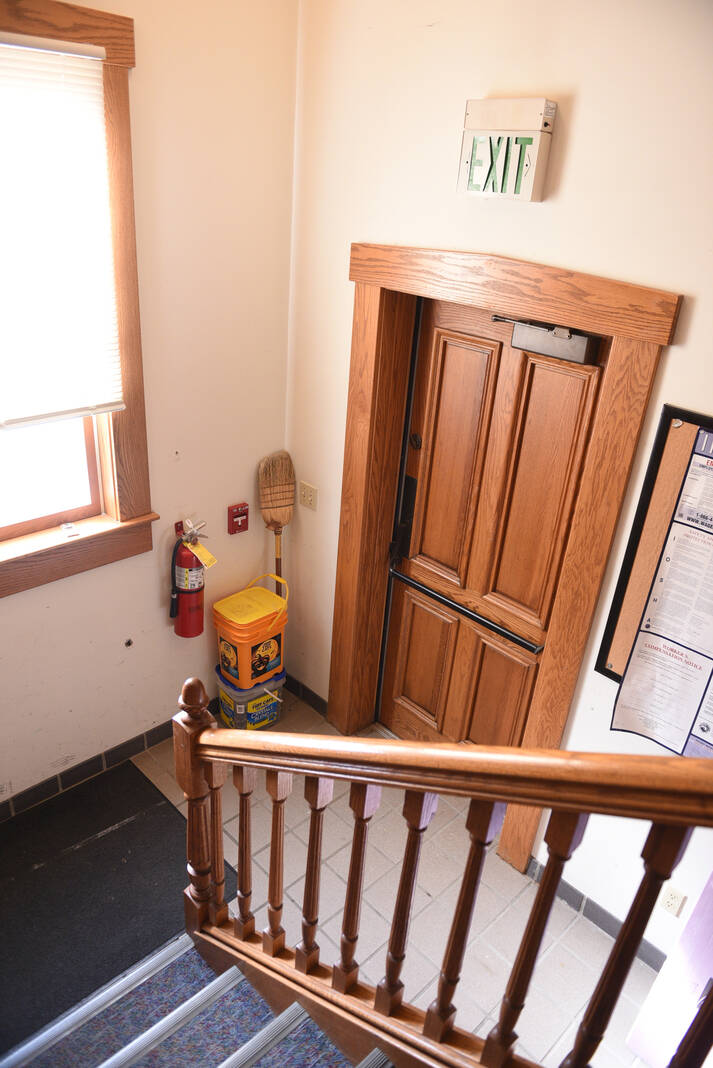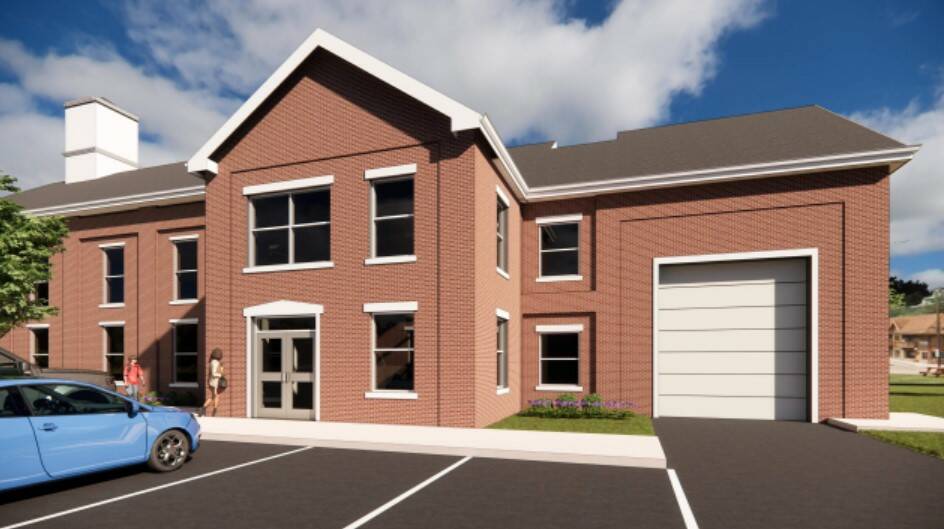After months of discussion, bid rejections and resubmissions, a bid was awarded for security additions to the Brown County Courthouse.
Brown County Commissioner Jerry Pittman announced last week that the money to fund security additions to the Brown County Courthouse had been identified and bid was awarded.
Five bidders competed in the race for the courthouse project, which were taken under advisement by commissioners in February.
At the Feb. 15 commissioner meeting, bids were opened for base and alternate bids, for the a sally port and security entrance respectively.
The lowest bidder, Building Associates, was awarded at the April 5 commissioner meeting, for a total of $1,060,277.
The company’s base bid for the sally port was $754,577; the alternate bid was $305,700 for the security entrance.
Bids were the result of the second round of bidding, after commissioners rejected a single bid made for the project in December. The project was then put out to bid again for competitive bids.
The awarded bidder will have a calendar date for 220 days for substantial completion, meaning that the building can be used for its intended purpose. At that point, they have 30 days to file completion.
The 220 days began April 5.
The cost of the contract will be paid for using part of a $75,000 grant Judge Mary Wertz applied for, and received, through the Indiana Office of Court Services last year to build a new sally port, addressing security concerns in the historic building.
Wertz said the upgrades are “absolutely essential” for the court to operate in this building.
At a commissioners meeting in June, Wertz formally asked the commissioners to help cover the remaining cost of the security upgrades.
This is the second time Wertz has received grant funding for security upgrades through the Indiana Office of Court Services. In January 2020, the county received a $30,000 grant to fund security work at the courthouse, which was built in 1877.
That grant was to be used primarily to restrict public access in the court offices on the second floor and the probation office on the first floor. It was also used to relocate the jury room to the law library on the second floor and to convert the small meeting room into a juror restroom that is compliant with Americans with Disabilities Act.
The commissioners also used around $30,000 from a $2 million capital improvement loan the county took out in 2018 to help cover costs of the ADA-compliant juror restroom and a new ramp entrance to the court office that is also compliant with ADA. The ramp is located to the right of the courtroom now as visitors enter.
At the June meeting, former commissioner Diana Biddle said the county has $500,000 set aside in the first round of American Rescue Plan Act funding the county received last year that could be used to fund the project. That money was originally set aside to purchase the former Career Resource Center building for the new prosecutor’s office, but the commissioners ultimately decided not to pursue that purchase.
The commissioners and the Brown County Council had multiple joint meetings in March in regards to rest of funding for this year’s project.
Pittman said last week the council ultimately did not feel they had excess money to put towards the project, and suggested the commissioners find the money within their own budget.
The project will be funded in part by ARPA funds, $3 million capital improvement loan money and some funds from commissioner expense accounts.
“Quite frankly I’ve been working feverishly since last Friday, to figure out where the money could come from and get it all done legally and properly, and not to deplete our funds in certain areas more than we have to, because maintenance is a total unknown,” Pittman said.
“It’s going to be a little tight, I’ll admit that, but I don’t think anything’s going to suffer unless we have a major bill that we can’t foresee.”
The only contingency is that approval is needed from the Brown County Council in moving money within the commissioners’ budget between line items.
Pittman said last week that he had spoken with Council President Gary Huett, who said he saw no problem with that. The next council meeting is Monday, April 17 at 6:30 p.m.
Pittman said the county council will also need to agree to amend the ARPA plan originally proposed and passed for a quality of life project, but money will be put toward the courthouse improvements instead.
“I want to get it done,” Pittman said.
“I think we’ll be okay doing it this way.”
Safe and secure
Wertz said that once renovations were done in 2020, it was recognized that there were two things missing to keep the courthouse’s integrity long into the future.
Those two things were a separate entrance for persons in custody entering the building, away from the general public, and a separate security entrance.
Currently, one small door on the east side of the building funnels all who enter the courthouse into a small hallway, where they must turn a corner to the security station before they enter the Brown County Clerk’s Office, probation office or the courtroom upstairs.
Story continues below gallery
“It’s always been recognized the security officer was placed in the wrong space because we didn’t have anywhere else to put him,” Wertz said on March 29.
“(The security officer) is well away from a door he cannot see, and around a corner. That creates a security hazard.”
There is no room for an X-ray in the space, so security officers must manually look through people’s belongings and personal effects.
“It’s just not appropriate. That’s been recognized since the beginning,” Wertz said.
The courthouse has never had a holding cell either, Wertz said.
In the 2020 renovation, the law library became the jury room, and it had been used as a makeshift holding cell for incarcerated persons.
The use of that room had its detriments, Wertz said, the room not having a restroom or functional security.
Since that renovation, we have nowhere to put incarcerated persons during their trials or during longer hearings. Instead, a small stairwell has been used on the north side of the building.
The last week of March, a jury trial that had gone on for quite some time had the court use an office changed into a holding cell.
The problem with that, Wertz said, is there are doors that cannot be secured and incarcerated persons are “mingling” with the court staff.
“There’s just a whole lot of big concern about that as well. That’s why we need that holding cell,” she said.
Historically, Wertz recalled when a holding cell would have been helpful in security measures.
A jury trial was once in session in the main courtroom and the magistrate was conducting a divorce hearing in the hearing room.
Wertz said there was a disruption in the hearing room that could be heard in the courtroom, and a jailer was struggling with an inmate who was a party in the divorce hearing, and had upended a table.
The bailiff at the time came in and they had to carry that gentleman out, kicking doors as they left the building.
“There are incidents,” she said.
A juvenile once responded to a court order in a manner that required EMS response. Instead of the juvenile being transported out via sally port, they were removed through the main door.
“There are ways we can control movement better if we have the two separate entrances and security officer hold people in that entrance while they take the inmate out the side door,” Wertz said.
“It just gives us a whole lot of opportunities to control that movement and reduce any opportunity for bad things to happen.”
A holding cell will have its own toilet and be a space where individuals can have private conversations with their council, be secure with window on the door that security officers can see through, and a control egress and access.
When prisoners are transported for trial, generally they are delivered to the front door in shackles. They should be entering through a separate entrance.
That’s where the sally port comes in, offering a type of garage space with a separate and secure entrance.
Individuals come not just from the Brown County Jail, Wertz said, but from Department of Corrections facilities, jails out of the county and other entities.
“It’s a risk to not only the public, but to law enforcement and the person themselves,” Wertz said.
“I almost had a mistrial this year because the inmate was delivered to that front door and there had been prospective jurors in the parking lot.”
The goal of the design is to make the structure “fit the look” of the courthouse so it didn’t look out of place, Wertz said. She also wanted to make sure the additions didn’t touch the 1870s structure, only the 1930s or 1950s additions.
Security isn’t the only measure the additions will provide. Wertz said she hopes that visitors to the courthouse will feel more welcome as well.
“When you enter the building, (new entrances) will not only make you feel more secure, but more welcome,” Wertz said.
“One thing I know is when people come to court … most times they are very stressed, and very upset. I want to put them in a place where they can do their work, have these proceedings be orderly and not have a lot of pent up anxiety.”
When a new security guard was hired, the main goal was to find an individual who is friendly and helpful, Wertz said, because that’s what was needed.
“We need people that are going to destress and not increase stress,” she said.
“The sheriff, the bailiff, everybody is going to be so much more content with a safe delivery method, in a place that is safe house people.”










